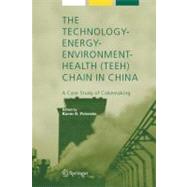
Note: Supplemental materials are not guaranteed with Rental or Used book purchases.
Purchase Benefits
What is included with this book?
| PREFACE | xi | ||||
| ACKNOWLEDGMENTS | xiii | ||||
| FIGURES | xxiii | ||||
| TABLES | xxv | ||||
| ABOUT THE AUTHORS | xxvii | ||||
| CHAPTER 1: INTRODUCTION | 1 | (8) | |||
|
1 | (1) | |||
|
2 | (1) | |||
|
3 | (1) | |||
|
4 | (2) | |||
|
6 | (1) | |||
|
7 | (2) | |||
| CHAPTER 2: THE COKE INDUSTRY IN CHINA | 9 | (14) | |||
|
9 | (1) | |||
|
10 | (1) | |||
|
11 | (2) | |||
|
13 | (9) | |||
|
13 | (7) | |||
|
20 | (2) | |||
|
22 | (1) | |||
| CHAPTER 3: ALTERNATIVE COKEMAKING TECHNOLOGIES IN SHANXI PROVINCE | 23 | (18) | |||
|
23 | (1) | |||
|
24 | (9) | |||
|
25 | (2) | |||
|
27 | (1) | |||
|
28 | (2) | |||
|
30 | (3) | |||
|
33 | (6) | |||
|
33 | (3) | |||
|
36 | (2) | |||
|
38 | (1) | |||
|
39 | (1) | |||
|
39 | (1) | |||
|
39 | (2) | |||
| CHAPTER 4: ENERGY-INTENSITY STRUCTURAL DECOMPOSITION ANALYSIS: CHINA AND SHANXI PROVINCE | 41 | (30) | |||
|
41 | (4) | |||
|
45 | (3) | |||
|
48 | (10) | |||
|
49 | (3) | |||
|
52 | (1) | |||
|
53 | (2) | |||
|
55 | (3) | |||
|
58 | (9) | |||
|
58 | (3) | |||
|
61 | (1) | |||
|
62 | (2) | |||
|
64 | (1) | |||
|
64 | (3) | |||
|
67 | (1) | |||
|
67 | (1) | |||
|
68 | (3) | |||
| CHAPTER 5: ENERGY EFFICIENCY AND PROFITABILITY DIFFERENCES: STATE-OWNED VERSUS TOWNSHIP-AND-VILLAGE ENTERPRISES | 71 | (20) | |||
|
71 | (2) | |||
|
71 | (1) | |||
|
72 | (1) | |||
|
73 | (5) | |||
|
78 | (3) | |||
|
81 | (4) | |||
|
85 | (3) | |||
|
88 | (1) | |||
|
88 | (3) | |||
| CHAPTER 6: MODELING COST AND POLLUTION OF COAL AND COKE TRANSPORTATION IN SHANXI PROVINCE | 91 | (18) | |||
|
91 | (2) | |||
|
93 | (1) | |||
|
93 | (2) | |||
|
93 | (1) | |||
|
93 | (2) | |||
|
95 | (3) | |||
|
96 | (1) | |||
|
96 | (1) | |||
|
96 | (2) | |||
|
98 | (1) | |||
|
98 | (8) | |||
|
98 | (3) | |||
|
101 | (1) | |||
|
102 | (2) | |||
|
104 | (1) | |||
|
105 | (1) | |||
|
106 | (1) | |||
|
107 | (2) | |||
| CHAPTER 7: HUMAN EXPOSURE TO ULTRAFINE PARTICULATES IN THE COKEMAKING INDUSTRY IN SHANXI PROVINCE | 109 | (24) | |||
|
109 | (2) | |||
|
111 | (6) | |||
|
117 | (6) | |||
|
118 | (2) | |||
|
120 | (1) | |||
|
120 | (3) | |||
|
123 | (1) | |||
|
123 | (5) | |||
|
128 | (2) | |||
|
130 | (3) | |||
| CHAPTER 8: A SOCIOECONOMIC PERSPECTIVE ON COKEMAKING IN SHANXI PROVINCE | 133 | (16) | |||
|
133 | (1) | |||
|
133 | (1) | |||
|
134 | (1) | |||
|
135 | (10) | |||
|
135 | (2) | |||
|
137 | (3) | |||
|
140 | (1) | |||
|
140 | (1) | |||
|
141 | (4) | |||
|
145 | (2) | |||
|
147 | (2) | |||
| CHAPTER 9: CONCLUSION | 149 | (10) | |||
|
149 | (1) | |||
|
149 | (4) | |||
|
150 | (1) | |||
|
151 | (1) | |||
|
152 | (1) | |||
|
152 | (1) | |||
|
153 | (1) | |||
|
153 | (2) | |||
|
153 | (1) | |||
|
154 | (1) | |||
|
154 | (1) | |||
|
154 | (1) | |||
|
154 | (1) | |||
|
155 | (2) | |||
|
155 | (1) | |||
|
156 | (1) | |||
|
156 | (1) | |||
|
157 | (1) | |||
|
158 | (1) | |||
| APPENDIX A: PHOTOS AND DESCRIPTIONS | 159 | (20) | |||
|
159 | (1) | |||
|
160 | (1) | |||
|
160 | (1) | |||
|
161 | (18) | |||
| APPENDIX B: ACRONYMS | 179 | (4) | |||
| INDEX | 183 |
The New copy of this book will include any supplemental materials advertised. Please check the title of the book to determine if it should include any access cards, study guides, lab manuals, CDs, etc.
The Used, Rental and eBook copies of this book are not guaranteed to include any supplemental materials. Typically, only the book itself is included. This is true even if the title states it includes any access cards, study guides, lab manuals, CDs, etc.